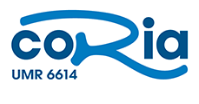Time-stretch imaging
Since 2017, CORIA has been experimentally developing innovative fast imaging techniques based on the concept of temporal stretching (dispersive Fourier transform). These techniques allow the monitoring of ultra-short phenomena (resolution of a few ns) over large time windows (several hundred µs). The development of such techniques, which is unique in Europe, has made it possible to monitor supersonic shock waves in real time. Current developments concern their realisation at different wavelengths.
First demonstration of real-time tracking of shock waves by time stretching: here.
For more information: P. H. Hanzard’s thesis.


Burst imaging (STAMP)
In parallel and as a complement to the time-stretching imaging techniques, the Optics and Laser Department is experimentally developing so-called burst imaging techniques. This involves recording images separated by only a few hundred femtoseconds by illuminating the object to be studied with frequency-drifting pulses. The different portions of the optical spectrum of these pulses, corresponding to different instants, are then spatially separated and imaged on a sensor.
This flexible and user-friendly technique has been implemented in the framework of M. Touil’s thesis and has been used to follow different phenomena on time scales ranging from picoseconds to nanoseconds. More details in the full paper available in open access here.





